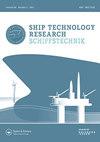Numerical simulation of a laser-induced cavitation bubble near a solid boundary considering phase change
IF 0.9
Q3 ENGINEERING, MARINE
引用次数: 17
Abstract
ABSTRACT This paper documents the numerical investigation of the flow surrounding a collapsing laser-induced cavitation bubble with an initial radius of 1.45 mm. The three-dimensional laminar flow was captured by solving the Navier–Stokes equations. To account for the multiphase flow (water and vapour), the Volume of Fluid (VoF) method was used. The source term of the transport equation of the VoF function was based on the simplified Rayleigh–Plesset equation. The distance of the bubble from a solid surface wall was varied according to the dimensionless parameter D/Rmax ranging from 0.3 to 3.0, where Rmax is maximum bubble radius and D is the distance between bubble centre and solid surface. Computed collapse derivatives, impact velocity, impact pressure, and visual characteristics, such as toroidal shapes of oval impacts, agreed favourably to experimental measurements.考虑相变的固体边界附近激光诱导空化气泡的数值模拟
摘要本文记录了初始半径为1.45的坍塌激光诱导空化气泡周围流动的数值研究 mm。通过求解Navier–Stokes方程来捕捉三维层流。为了说明多相流(水和蒸汽),使用了流体体积(VoF)法。VoF函数输运方程的源项基于简化的Rayleigh–Plesset方程。气泡与固体表面壁的距离根据范围为0.3至3.0的无量纲参数D/Rmax而变化,其中Rmax是最大气泡半径,D是气泡中心与固体表面之间的距离。计算的坍塌导数、冲击速度、冲击压力和视觉特征,如椭圆形冲击的环形,与实验测量结果一致。
本文章由计算机程序翻译,如有差异,请以英文原文为准。
求助全文
约1分钟内获得全文
求助全文

 求助内容:
求助内容: 应助结果提醒方式:
应助结果提醒方式:


